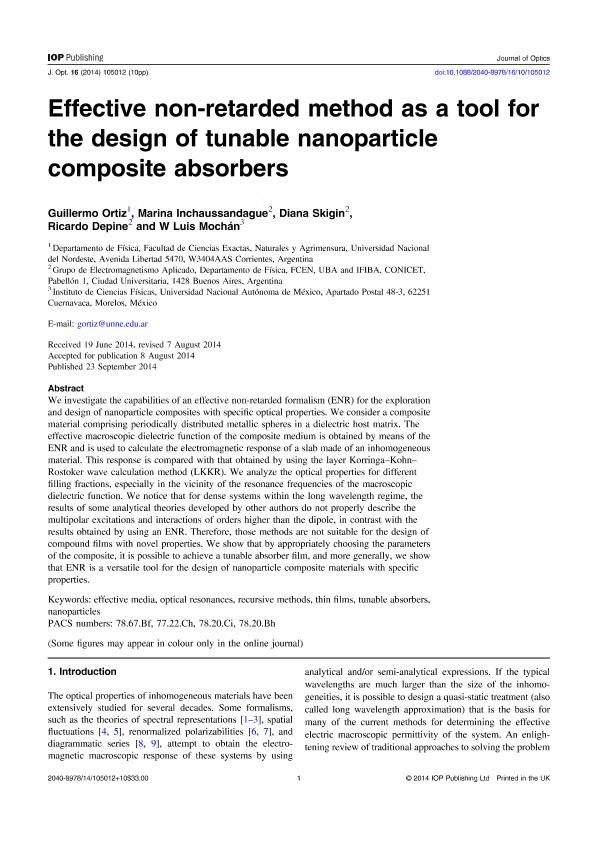Mostrar el registro sencillo del ítem
dc.contributor.author
Ortiz, Guillermo
dc.contributor.author
Inchaussandague, Marina Elizabeth

dc.contributor.author
Skigin, Diana Carina

dc.contributor.author
Depine, Ricardo Angel

dc.contributor.author
Mochán, W. Luis
dc.date.available
2017-06-15T17:48:32Z
dc.date.issued
2014-09
dc.identifier.citation
Ortiz, Guillermo; Inchaussandague, Marina Elizabeth; Skigin, Diana Carina; Depine, Ricardo Angel; Mochán, W. Luis; Effective non-retarded method as a tool for the design of tunable nanoparticle composite absorbers; IOP Publishing; Journal of Optics; 16; 10; 9-2014; 1-10; 105012
dc.identifier.issn
2040-8978
dc.identifier.uri
http://hdl.handle.net/11336/18256
dc.description.abstract
We investigate the capabilities of an effective non-retarded formalism (ENR) for the exploration and design of nanoparticle composites with specific optical properties. We consider a composite material comprising periodically distributed metallic spheres in a dielectric host matrix. The effective macroscopic dielectric function of the composite medium is obtained by means of the ENR and is used to calculate the electromagnetic response of a slab made of an inhomogeneous material. This response is compared with that obtained by using the layer Korringa–Kohn– Rostoker wave calculation method (LKKR). We analyze the optical properties for different filling fractions, especially in the vicinity of the resonance frequencies of the macroscopic dielectric function. We notice that for dense systems within the long wavelength regime, the results of some analytical theories developed by other authors do not properly describe the multipolar excitations and interactions of orders higher than the dipole, in contrast with the results obtained by using an ENR. Therefore, those methods are not suitable for the design of compound films with novel properties. We show that by appropriately choosing the parameters of the composite, it is possible to achieve a tunable absorber film, and more generally, we show that ENR is a versatile tool for the design of nanoparticle composite materials with specific properties.
dc.format
application/pdf
dc.language.iso
eng
dc.publisher
IOP Publishing

dc.rights
info:eu-repo/semantics/openAccess
dc.rights.uri
https://creativecommons.org/licenses/by-nc-sa/2.5/ar/
dc.subject
Homogenization
dc.subject
Effective Media
dc.subject
Recursive Methods
dc.subject
Absorbers
dc.subject.classification
Óptica

dc.subject.classification
Ciencias Físicas

dc.subject.classification
CIENCIAS NATURALES Y EXACTAS

dc.title
Effective non-retarded method as a tool for the design of tunable nanoparticle composite absorbers
dc.type
info:eu-repo/semantics/article
dc.type
info:ar-repo/semantics/artículo
dc.type
info:eu-repo/semantics/publishedVersion
dc.date.updated
2017-06-12T18:05:26Z
dc.journal.volume
16
dc.journal.number
10
dc.journal.pagination
1-10; 105012
dc.journal.pais
Reino Unido

dc.journal.ciudad
Bristol
dc.description.fil
Fil: Ortiz, Guillermo. Universidad Nacional del Nordeste. Facultad de Ciencias Exactas Naturales y Agrimensura; Argentina
dc.description.fil
Fil: Inchaussandague, Marina Elizabeth. Consejo Nacional de Investigaciones Científicas y Técnicas. Oficina de Coordinación Administrativa Ciudad Universitaria. Instituto de Física de Buenos Aires. Universidad de Buenos Aires. Facultad de Ciencias Exactas y Naturales. Instituto de Física de Buenos Aires; Argentina
dc.description.fil
Fil: Skigin, Diana Carina. Consejo Nacional de Investigaciones Científicas y Técnicas. Oficina de Coordinación Administrativa Ciudad Universitaria. Instituto de Física de Buenos Aires. Universidad de Buenos Aires. Facultad de Ciencias Exactas y Naturales. Instituto de Física de Buenos Aires; Argentina
dc.description.fil
Fil: Depine, Ricardo Angel. Consejo Nacional de Investigaciones Científicas y Técnicas. Oficina de Coordinación Administrativa Ciudad Universitaria. Instituto de Física de Buenos Aires. Universidad de Buenos Aires. Facultad de Ciencias Exactas y Naturales. Instituto de Física de Buenos Aires; Argentina
dc.description.fil
Fil: Mochán, W. Luis. Universidad Nacional Autónoma de México; México
dc.journal.title
Journal of Optics
dc.relation.alternativeid
info:eu-repo/semantics/altIdentifier/url/http://iopscience.iop.org/article/10.1088/2040-8978/16/10/105012/meta
dc.relation.alternativeid
info:eu-repo/semantics/altIdentifier/doi/http://dx.doi.org/10.1088/2040-8978/16/10/105012
dc.relation.alternativeid
info:eu-repo/semantics/altIdentifier/url/https://arxiv.org/abs/1403.1753
Archivos asociados
